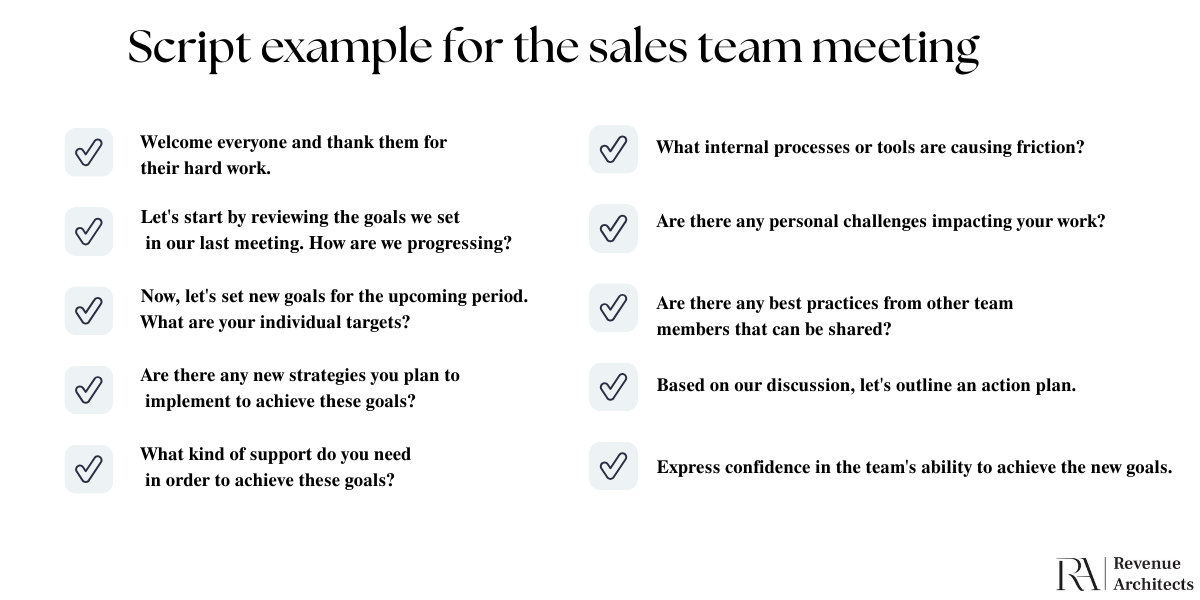When you work in a company, you risk contracting a condition that severely impacts the productivity and motivation of your colleagues: chronic meetingitis. This “illness” requires constant meetings to address topics that could easily be summarized in an email.
This doesn’t mean we should avoid meetings altogether. Instead, we must dedicate time and plan future meetings to ensure their success, especially regarding a sales meeting. While there are many reasons to hold a meeting of this type, one objective always is to achieve its purpose.
How do you do that?
That’s why we share this article with you.
A sales meeting is a gathering organized by a company, where the members of its sales team play a crucial role. They exchange ideas, discuss strategy policies, set objectives, welcome new personnel, and share news about the business’s products or services. Their active participation and contributions are vital for the success of the meeting and the company’s operations.
Most of the time, those who attend the sales meeting belong to the sales force. However, there are also occasions when it’s beneficial to invite external parties such as suppliers, partners, or clients. Their presence can provide valuable insights, foster stronger relationships, and align everyone’s understanding of the business’s products or services, depending on the purpose of the meeting.
One of the key purposes of a sales meeting is to bring together all the team members occasionally. This provides a unique opportunity for growth and learning, allowing them to get to know new team members and strengthen bonds. It’s a platform where they can share their ideas, improve workflow, and collectively work towards achieving departmental goals.
To maximize the effectiveness of your sales meetings, we will provide tips to ensure that the time you invest in them results in positive outcomes for your team, improved work processes, and increased sales.
Even if it’s a weekly, monthly, or quarterly commitment, there must be a reason for your sales meeting. This makes it easier to plan, from selecting and inviting the attendees to the objective that should be achieved by the end. This also provides an opportunity to identify the materials worth bringing to the meeting, the formats to present them in, and the time needed to convey them.
Knowing the reason for the sales meeting helps you determine who should attend. This is very helpful because you can prepare the space according to your needs. For instance, some team members might be out of the office on a business trip or work remotely, so you’ll need an internet connection and a camera to share video with that part of your team. Perhaps someone has mobility issues, and you must arrange accessible spaces and entrances.
If it’s a meeting with clients and suppliers, you must implement a different protocol for hosting external individuals. This aligns with the channels for the invitation: personalized email, phone call, or a bulletin on the team’s Slack.
Reserve the space to avoid interruptions during the meeting, ensure enough seats for all attendees, and provide screens, internet, or audio. The type of information to be shared, the meeting’s objective, and its intention will dictate the support, resources, and devices needed to ensure your meeting proceeds smoothly and your message reaches your audience clearly and effectively.
When preparing the meeting, even if you want it to have an informal vibe, it’s a good idea to outline a script. It can be simple, just a list of the main points that will guide its progress and help achieve the meeting’s objective. This helps make better use of everyone’s time, so you don’t have to call another sales meeting to cover a topic missed in the session you just organized.
Here is a simplified example of one meeting, which you can moderate each time.

The person who directs or calls the meeting can also take on the role of the moderator. If this is not possible, assigning this role to someone else is essential. The moderator’s role is to ensure orderly participation, manage the flow of the meeting, and keep the discussion focused on the meeting’s purpose. This is crucial in avoiding interruptions or straying from the primary objectives of the meeting, thereby contributing to a more productive and successful meeting.
Even when few people are present, a meeting can descend into chaos, turning a 10-minute gathering into a one-hour headache.
To maintain the attention of your attendees, include elements that make the information and message you want to share more digestible. Please don’t focus on creating a 60-slide PowerPoint presentation; instead, decide when it’s a good idea to support what you’re saying with a visual aid. Sometimes, it’s more effective to plan an entertaining speech based on storytelling that presents critical data visually without relying entirely on people reading everything on the screen.
If you have an audience through digital platforms like Zoom or Google Meet, managing the time is essential so people watching you from a screen stay energized. This is mainly because, given their work model, they might already experience screen fatigue, known as “Zoom fatigue.”

In a sales meeting, it’s important to maintain a cordial atmosphere, even when discussing potentially sensitive topics. For instance, if it’s time to discuss team performance problems, it’s crucial to steer the conversation towards constructive criticism, where solutions are proposed, not blame. This approach fosters a positive and supportive environment, encouraging everyone to participate and share their opinions, which can lead to more effective problem-solving and decision-making.
This will also make attendees more confident in participating and sharing their opinions. Otherwise, you risk losing valuable insights and making people feel attacked.
Always leave the final minutes of a sales meeting to resolve questions and clarify details. This could include discussing the conditions for new objectives, the start date for a new sales strategy, or any other points that may need further clarification. Ensuring that no one leaves with doubts is crucial, as it ensures that the meeting has served its purpose and that everyone is on the same page moving forward.
And if someone has a suggestion to make the next meeting even more enjoyable and smooth, accept the comment in your favor. The idea is that these gatherings add value to your team, so those who make it up provide valuable feedback.
Minutes record the topics discussed, agreements reached, objectives, and tasks to be completed. Like the moderation role, assign it to someone who can focus on these aspects so you’re not distracted from leading the meeting. In any case, you’ll need to verify that everything mentioned is included in the minutes, and you can review them aloud at the end so that if someone notices an omission, it can be pointed out immediately.
Write a summary of the meeting to send to all interested parties. It serves as a reminder, as it’s common for daily work overload to make people forget the conclusions, agreements, and valuable contributions from this meeting and will impact your sales team’s work.

Remember, every meeting is a golden opportunity to exchange ideas with your sales team, suppliers, and clients. Rather than dominating the conversation, focus on listening and valuing everyone’s input. Their insights can spark solutions, enhance strategies, and foster stronger teamwork.
We hope your future meetings are both concise and impactful, making the most of your valuable time. If you ever need tailored guidance from seasoned professionals like Mario and Noam, don’t hesitate to reach out. We’re here to help you craft effective strategies for your sales team.
Growthnetix OÜ
Harju maakond Kesklinna
linnaosa, Ahtri tn 12, 10151
Tallinn, Estonia
VAT number: EE102550717